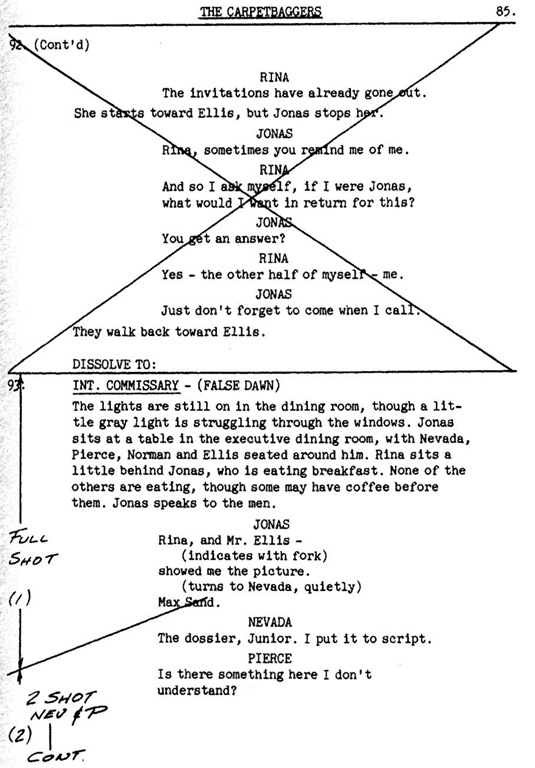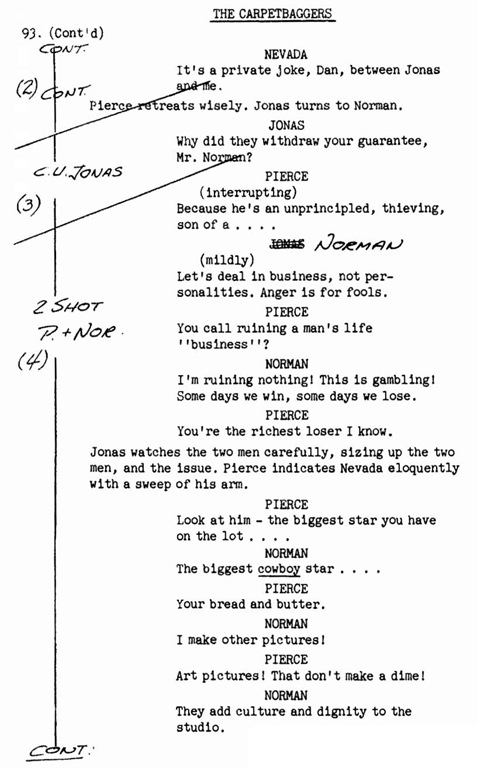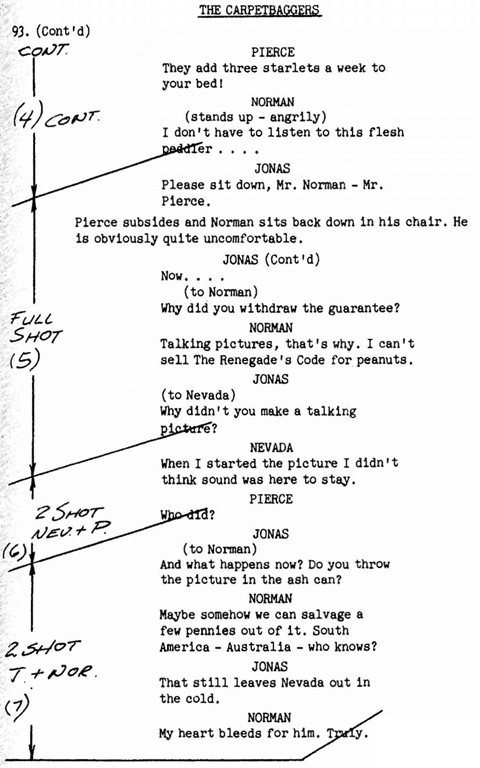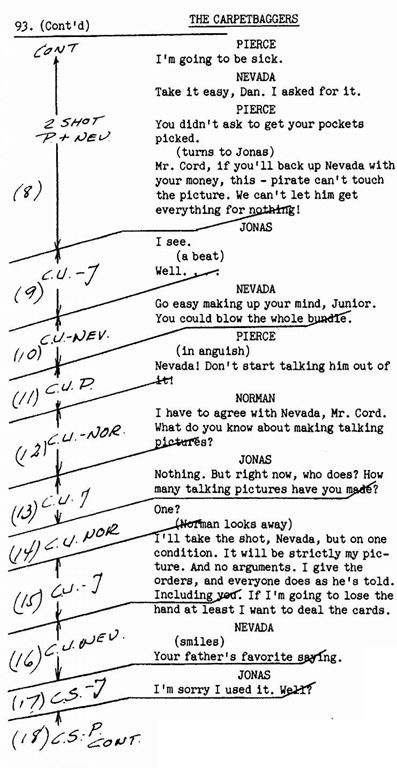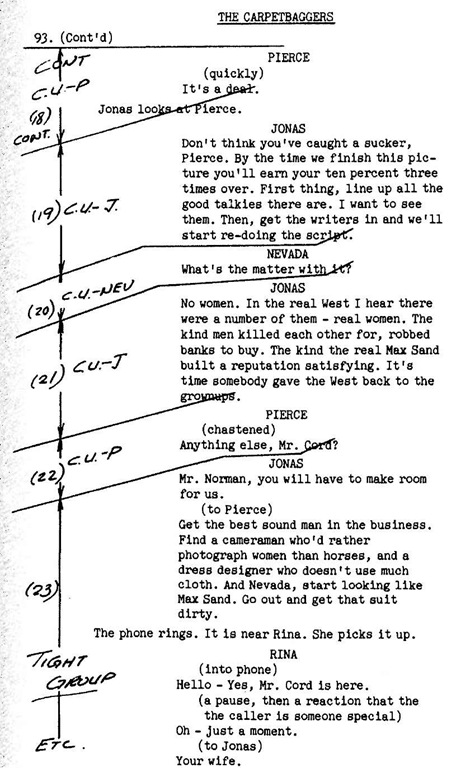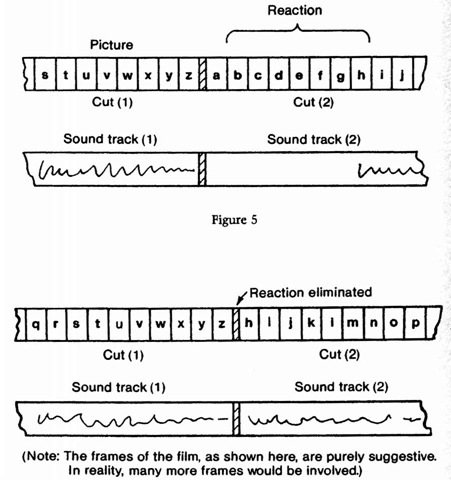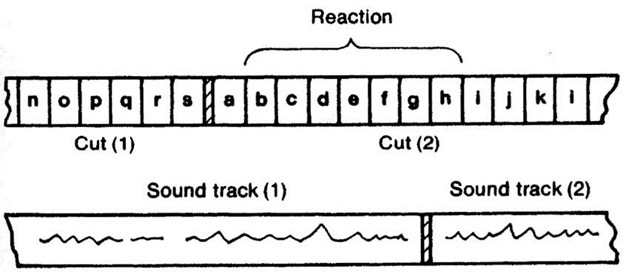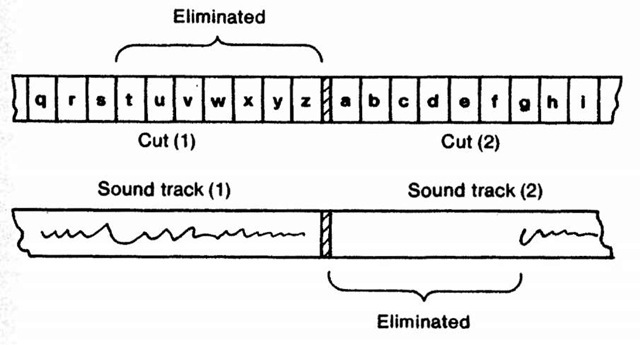Good drama is never an essay, a lecture, or a straight narrative. It is always cause and effect, action and reaction, even when no physical activity is involved. A good dialogue scene is rarely a straight interchange of declarative lines or overt plot exposition, no matter how brilliantly written; it contains conflict, surprises, "twists," and "food for thought"—something for the actor, as well as the viewer, to ruminate.
In all good films it is essential that the characters grow or, to put it more accurately, develop, and such development is most effectively shown through their reactions either to physical crises or to verbal stimuli. These are the "moments of transition” which every actor and director looks for in the script’s scenes, whether or not they consciously identify them as such. In addition, these are the moments of which every film editor should be especially aware, the moments which he should treat with special care.
Such moments contain two elements. Let us call them the "delivery" and the "reaction." Proper timing for each is of the greatest importance; where to cut away from the delivery , and where to cut to the reaction may be most productively ; investigated in the context of dialogue scenes, since these are the scenes which, in the present state of the art, dominate " most films.
First, however, let us examine a typical cutting breakdown | for such a scene without regard to the niceties of the editing. § Our example is a single five-page scene excerpted from the I shooting script of The Carpetbaggers (Figure 4). It is not only a good sampling of several types of cuts.
The script was written by John Michael Hayes, at that time (1963) one of Hollywood’s most highly regarded writers. It will be noticed that the five pages (the last half page is omitted because it is of no concern to us) are written as one master J shot, even though the most cursory reading will reveal that a J number of setups and cuts are required to properly develop the • scene’s several dramatic elements. (As the scene is broken down, it consists of 23 cuts derived from 10 or 11 setups— J specifically, 4 close-ups, 3 two-shots, 2 or 3 group shots, and ; probably a reaction cut of Rina). The custom of writing "| dialogue scenes in master shots is the rule rather than the exception. |
Our scene is "marked up" (admittedly more neatly than in \ the working version) with the director’s cutting instructions ] for the editor who is to make the first cut. The cuts are num- ; bered here for the convenience of analysis, but the rest of the ; directions, including setup identification (e.g., 2 shot, Nev. & -P.) and the slanting lines that indicate cutting points, are much as they were in the original breakdown. I]
On the whole, this is a straightforward sequence, and even if I had not shot and cut t&e scene some 20 years ago, I would, today, still probably break it down much as indicated. Of course, the proper cutting concept would have to be based on the cutter’s knowledge of the characters, as learned from previously filmed material. Without that knowledge, the cutting sequence might be quite different, even though the cutter had access to the script. Characters as written and characters as played are often surprisingly different.
In order to furnish "live" footage for the dissolve into the full shot (1), as well as to set up the scene and its personnel, certain "business," or action, not indicated in the script was extemporized when the scene was shot.
Figure 3
Figure 3
Figure 3
Figure 3
Figure 3
The number 2 cut, a two-shot of Nevada (Alan Ladd) and Pierce (Bob Cummings), enables us to accentuate a previously established "in" relationship between Nevada and Jonas (George Peppard). It also allows us to slide more smoothly, on Nevada’s meaningful look toward Jonas, at the end of the cut, into:
Cut (3), a close-up of Jonas. This shot prepares us, gently, for Jonas’ eventual domination of the situation and the people involved in it as it gets us back to the business at hand. Jonas’ line, although spoken to Norman (Marty Balsam), brings an angry comment from Pierce, so:
Cut (4) is a two-shot of Pierce and Norman. A close-up of t Pierce at this point, even though he is the speaker, would probably confuse the viewer, since Jonas, in the previous cut, has addressed Norman. The two-shot allows us to see the person addressed and to catch the interruption without confusion. This is the second two-shot which includes Pierce, and it serves to call attention to the director’s responsibility for staging "cutting-compatible" setups. Nevada, Pierce, and Norman had to be placed in positions which would permit a two-shot of Nevada and Pierce and another of Pierce and Norman. Of course, these two two-shots could never be directly inter- j cut without Pierce "jumping" from one side of the screen to [ the other, but either could be used when needed by cutting \ away from or to a close-up or, as in (6) to (7), to another two- , shot of two different people. The third two-shot (7) of Jonas j and Norman further complicates the staging and the cutting, j but the previously stated rule applies also to this setup. If all this seems a touch complicated, rest assured—it is. Even experienced directors occasionally goof in such a situation.
To resume our analysis: cut (4) is a scene of bickering conflict, rapidly paced, with dialogue overlaps. Since no reactions of special import are present, it plays well in the two-shot. A t group shot here would weaken the scene, and close-ups, as \ indirectly suggested by the writer's direction, "Jonas watches | the two men carefully," would overstate the importance of ; the nattering and minimize the value of the close-ups to be used at the scene's climax. Cut (4) plays for a full page, some 40 to 45 feet at this rapid pace. The cut to (5) is then made in movement, on Norman's rise.
This kind of "action cut," involving dialogue, is quite common—and often quite troublesome. The actor rises as he speaks, but rarely does he do so at exactly the same point in each take (or setup) and rarely does the sound perspective of the two setups match. The best solution here is to cut for the picture match, allowing the dialogue from the two-shot to continue over the full shot. Even if the words do not synchronize exactly (and it would be a miracle if they did), the viewer's attention will not be sharply focused as it shifts with the action of the cut. By the time the viewer's attention is focused, that particular line of dialogue will have been completed and the next line, now properly that of the full shot, will have taken over. (An interruption here might be another complication, but more about that later.)
To resume, cut (5), a full shot, permits us to unruffle a few feathers, draw a deep breath, strengthen Jonas' position, and get back to the real business of the scene, while pulling away momentarily from what is really a secondary conflict, as we once again begin to build to a more dramatically sound (and inevitable) climax to the sequence.
With cut (6) we start to zero in on the real objective of the sequence, Jonas' takeover of Nevada's film, which, in turn, will soon impel Jonas firmly into the motion picture business.
Cuts (7) and (8) continue our two-shot buildup to what will be an extensive, rapid-fire intercutting of close-ups—cuts (9) through (22).
Cut (23) brings us back to earth. Associations and antagonisms which have become major story developments have been firmly established, and decisions, for good or ill, have been unalterably made. And to "springboard" us into the next sequence, the telephone rings, breaking the tension and bringing Rina (Carroll Baker) back into the scene.
These, briefly, were the cuts and the imperatives which led to them. Given the same setups and equal knowledge of the characters' earlier developments, half a dozen cutters, each assessing the sequence on his own, would probably cut it in < much the same way, although minor variations would cer-1 tainly occur. A television cutter would probably use more -close-ups; an "old-timer" perhaps not quite so many. But in . this breakdown one important element has been temporarily j; set aside. Exactly where, in each cut, does the cutter leave the scene and exactly where does he start each incoming cut? In this area, the cutters' techniques might vary considerably, and it is here that such variations might enhance or damage the f tone, the pace, and the impact of each cut separately and the { sequence as a whole. Let us now retrace our steps and examine I: each cut as carefully as we can with this element in mind.
Before we can properly handle an exchange of dialogue, however, we must first understand the grammatical nature of our language.* In speaking English, preferred usage generally requires that the subject be placed near the start of a sentence and that it be followed almost immediately by the predicate, whether simple or compound. The rest of the sentence, which might be quite long, usually consists of explanatory, enlarg- ! ing, or modifying phrases and/or clauses. Certainly, in the majority of instances, the sense of any statement is manifest before that statement is completed. This leads to a common and sometimes unjustly condemned habit—the habit of interruption. p
In most conversations, often even in well-chaired discus- ;; sions, people frequently, sometimes constantly, "cut in" on 1 each other. A conversation without interruptions may be r polite—it is also, quite probably, very dull. Interruptions are . not necessarily a sign of rudeness, but of eagerness. Anticipat- I ing the finish of a speaker's sentence, the listener is eager to I respond, whether in assent or disagreement. Even if the list- k ener remains silent, he will often react with a nod of approval, ? a grimace of doubt, or a frown of rejection well before the end of the speaker's statement, and although a spoken sentence may occasionally deliver a surprise ending, in the great majority of instances, this simply is not so.
In effect, whether with a verbal or nonverbal response, the listener usually reacts before the speaker has finished speaking—and so does the viewer. He too is a listener, and it is the viewer's awareness of the listener's point of reaction which properly determines a dialogue cut. With the foregoing in mind, let us more closely examine the cuts in our sample scene.
The cutaway from cut 1 should be made substantially as indicated by the diagonal line—somewhere in the middle of the word Sand. The viewer is aware of its significance because of an earlier scene, and he is now interested in its effect on Nevada. To linger on the cut, as many cutters would, is to lag behind the viewer, and that is a cardinal sin.
The average film viewer is a highly conditioned animal. He has seen hundreds of films and thousands of "situations." Rarely does he experience a truly original scene. His grasp of dramatic situations is usually quite broad, and his reactions to actors' lines very swift indeed. His tolerance of the ordinary should not be mistaken for stupidity. "Talking down" to an audience is a fool's occupation. It is difficult enough to "stay even" with the viewer—one need rarely worry about being "ahead" of him. The filmmaker must always try (although only a few will completely succeed) never to fall behind. That way leads to boredom, inattention, and failure.
At the end of cut (1), many cutters will allow the outgoing scene to run until they are sure the word Sand is quite finished. Since they do not, quite properly, want to risk cutting into the word, they give themselves a few extra frames for protection. This is good practice, as far as the sound is concerned, but there is no need to run the picture as long as the sound track. Picture and sound need never be cut simultaneously, and cutters who overlap infrequently are doing inferior work. In this particular example, it would mean that the cut has been made quite a number of frames after the proper picture cutting point, causing the viewer a moment of unwelcome distraction and an unnecessary lengthening of the cut (compare Figures 5 and 7).
The extra frames at the end of cut (1), combined with the three or four "empty" frames (see p. 60) at the beginning of cut (2), can add up to as much as a full second of "dead" time between the point at which the viewer anticipated Nevada's reaction to Jonas' line and the point at which the reaction was finally delivered.
Figure 6
The "stall" is lengthened, and often when the director or producer pronounces, "It's 20 minutes too long. Cut it down!" the cutter, maintaining his "straight across" cut at the end of (1) will clip off the beginning of the reaction in (2). This will save some frames by bringing Nevada's verbal response closer to Jonas' line, but at the expense of Nevada's visual response, his reaction, which is, in classical film sense, much more important (see Figure 6).
Figure 7
For the proper (and much better) cut, see Figure 7. This "overlap" saves as much footage, and time, as the "straight across" cut in Figure 6, yet it retains all of Nevada's reaction.
Here, an equal, though not matching, amount of picture and track have been eliminated, while the important elements of the scene have been retained (Figure 8).
Figure 16
By cutting from (1) to (2) at the point where the viewer looks at Nevada, we are able to camouflage our cut without f resorting to the "deception" of physical movement. The \ movement here is mental on the part of the viewer, and self- \ willed, since he wants to see Nevada's reaction to Jonas' line. I If we hit it exactly, we present Nevada in a two-shot just as the viewer's eyes refocus on the scene, showing him what he f wants to see and, incidentally, rendering our cut "invisible" f (because it is made while the viewer shifts his eyes). We are ; able to show Nevada's complete reaction (preceded by three or j1 four "empty" frames), we shorten the pause between the two : scenes, and we keep the dialogue flowing.
This is the key principle for cutting dialogue. There are ex- : ceptions, but the great majority of dialogue cuts can be made f after this fashion. The advantages are obvious—the cut "goes S with" the viewer's awareness, it "hides" our cut, it conforms j to rules 4, 5, and 6, and it enables us to maintain a tighter pace and a smoother flow.
It provides the brief moment needed by the viewer to focus ; on the new scene. If the cut were to be made just one frame j ahead of the start of the reaction, the viewer would miss it, j catching it already under way, a most undesirable effect.
To proceed, the cutaway from (2) is not made as quickly as i indicated. There is a moment's pause as Pierce "retreats wisely"; then Nevada looks back at Jonas. The cut is made on the "look off" principle.We get to Jonas, in (3), in time for a slight reaction to the interchange in the previous cut, which is followed by the transfer of Jonas' attention to Norman. This close-up is also needed to separate the two two-shots, each of which pairs Pierce with a different actor.The cutaway from (3) returns us to the overlapping principle of (1), especially since Pierce actually cuts in on Jonas.
Cuts (4) and (5) have been covered earlier in the topic. The cut-away to (6) employs the overlap, since no time for thought on Nevada's part is necessary. The same is true for the cutaway from (6) to (7).
At the start of (7), time is allowed for Jonas to transfer his attention from Nevada and Pierce to Norman. Jonas probably has a brief reaction to Pierce's "Who did?" before he shifts to Norman. Here too, as at the beginning of all cuts, the three or four "empty" frames preceding Jonas' reaction, no matter how slight, must be included.
The cutaway from (7) is overlapped by the beginning of (8). Pierce actually reacts to "for him," so this extends his reaction slightly. His line is a near interruption of "Truly."
Cut (8) delivers the challenge to Jonas. Again, we use the overlap, as indicated, to cut to (9).
Cut (9) starts a series of close-up intercuts. The first, on (9), is known in cutter's parlance as a "timed cut." Jonas takes a moment to digest Pierce's last remark—his "well . . ." indicates the beginning of some decision that Nevada tries to forestall. Here the timing of the cutaway from (9) is instinctual. The cutter must guess at which point the viewer will look to someone for a reaction. A good cutter will guess right most of the time. The cut to Nevada (10) takes place during the look.
The cutaway from (10) is a natural overlap. We know that Nevada's line will cause Pierce some anguish, and we are eager to see his reaction in (11). From here on the cuts proceed at a rapid pace. The ends of all lines overlap, but the reactions at the start of the cuts are important and must be carefully timed and protected. There is one cutaway to a silent reaction of Norman (14). This starts as an overlap on Jonas' word "made?" His next word, "One?", comes over Norman's close-up. Norman's reaction to the question is obviously important, since it drives home to him, but really to the viewer, a very vital point, one which makes Jonas' forthcoming decision seem quite inevitable. As Norman looks away, we cut back to Jonas (15). Here, an extension of the "silent" part of the track may be necessary, since the full development of Norman's reaction and Jonas' awareness of that reaction is crucial. Such extensions of timing are often necessary and will be dealt with in a future topic.
Cut (15) shows Jonas' full reaction to cut (14). It is important that he be aware of the effect of his "put-down" of Norman. The cutaway to Nevada (16) comes early, on Jonas' line, "including you." This is a key condition—the "gauntlet."
Nevada's reaction, by no means a foregone conclusion, is also [ important. Jonas' off screen line is merely a restatement of earlier words put in terms Nevada can easily understand and accept. Nevada's answer, in (16), is a partial evasion, as well as a slight "getting even" with Jonas. Nevada is trying to retain his dignity even though he knows, as does the viewer, that he must accept Jonas' terms. The cutaway from (16) is an overlap, especially since Jonas (17) reacts sourly to Nevada's implication. His question, "Well?", is overlapped by:
Pierce, in cut (18). His quick reaction and line are matched by an equally quick overlap to (19). From here on, the end of each cut overlaps the start of the following cut, down to the end of the sequence.
Before concluding this area of cutting it is important to mention at least two exceptions to the quick overlapping technique. The first, already mentioned but not singled out, is not truly a dialogue cut, but it often comes up in dialogue situations,- it is exemplified in Figure 4 in the cutaway from (2) to the close-up of Jonas (3). Although the dialogue in (2) has been completed, the viewer's attention is held by the visual interplay between Pierce and Nevada. The viewer must be allowed the time to absorb Pierce's important reaction of "retreat," at the end of which his attention is directed to Jonas (3) by Nevada's look-off. In (3) Jonas continues the interplay briefly, then changes the subject of the conversation and the direction of the scene. The movement from (2) to (3) is based on the ! "look-off" principle, but the cutter must know which "look- ] off" to look for.
The second exception is of a different and much more subtle j nature. It concerns the posterior elongation of close-ups in a flow-of-dialogue scene, especially where the lines and the reactions deliver different messages. This is best illustrated by an example from Leo McCarey’s Love Affair, starring Irene Dunne and Charles Boyer.
These two actors play star-crossed lovers whose long-awaited rendezvous at the top of the Empire State Building is thwarted when Dunne, hurrying across a traffic-crowded street within sight of the meeting place, suffers a crippling accident. Unaware of the mishap, Boyer assumes he has been "stood up." On her part, Dunne refuses to contact Boyer because she is now a quadriplegic.
In time, their paths cross, but under circumstances which still leave him ignorant of her physical condition. Piqued by their chance meeting and still very much in love, Boyer visits Dunne at her home. She successfully conceals her handicap by remaining seated throughout his visit. In the ensuing scene, Boyer’s pride and Dunne’s reluctance lead them both to avoid the truth as they recount their versions of the missed rendezvous. Yet this is the climax of the film, and it is mandatory that the truth emerge despite the fact that it is never voiced. Obviously, it could be done only through "attitude" or reaction, but not obviously.
Boyer and Dunne were masters of reaction. In this climactic scene, their "looks" had to belie their words, but in a most subtle fashion. These "looks" came after the spoken lines, being, in a sense, reactions to their own words. Therefore, it was necessary to stay with each close-up after the speaker’s line had been completed, if only for a brief moment. Only then could a cut be made to the necessary reaction and response, at the finish of which would come another subtle ambiguous "look."
Since the viewer was completely aware of the situation, it was necessary to get him involved in a game of a sort—not if, since that was inevitable, but how and when will Boyer realize the truth. In this instance, the viewer participated in the game willingly, enjoying the delayed "looks" and eagerly anticipating Boyer’s moment of truth. The beauty and genius of the scene lay in the fact that the denouement was brought about wholly by the "looks," or reactions, which followed completely plausible verbal deceptions.
Such scenes are rare because the teaming of such talent (including the writing and direction) is rare. But now and then a line or two of this nature does surface. The editing of such a sequence demands as much timing sensitivity as does the staging. The cutter must feel the exact point in the delayed reaction at which the viewer will look for a counter reaction, and a cut made at this point will inevitably be proper and smooth.
But cutting away from and to almost any reaction requires a finely honed sense of timing, which only practice can properly develop. However, a few hints may help, and in any case, this category deserves at least a brief consideration in its own right.
